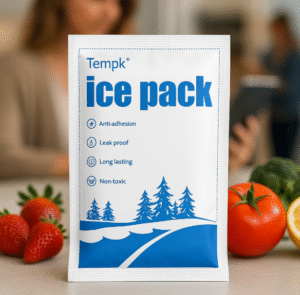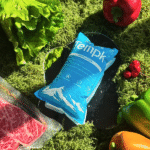Pacote de gelo seco Austrália: O 2025 Envio, Dimensionamento & Manual de segurança
-
O que são pacotes de gelo seco e quando usá -los
-
2025 conformidade na Austrália (ar, estrada/ferrovia, publicar)
-
Como dimensionar os pacotes de gelo seco (dois métodos rápidos)
-
Pacote & Lista de verificação de etiqueta (cópia pronta)
-
Segurança no local de trabalho (Co₂ & ventilação)
-
Perguntas frequentes para remetentes (2025 regras)
-
Dados estruturados (JSON -LD)
-
Idéias de link interno
1) O que Pacotes de gelo seco são - e quando usá -los
O que eles fazem: O gelo seco esfria por sublimação a ~ −78,5 ° C e absorve o calor com muita eficiência (entalpia de sublimação ≈ 571 KJ/kg). Mantém os produtos realmente congelados sem água derretida, o que é ideal para sorvete, frutos do mar, e biológicos congelados.
Matérias de expansão de gás: À medida que o gelo seco se transforma em gás co₂, ~ 1kg → ~ 541L de gás. É por isso que os pacotes devem ser ventilados - nunca.
Pellets vs blocos: Pellets esfriam mais rápido (mais área de superfície), Os blocos duram mais (Índice inferior da área de superfície para volume). Use blocos para espera longa; Adicione uma camada superior de pellets quando precisar de um puxão rápido.
Gelo seco vs gel/pcm (regra rápida):
-
Precisar congelado (≤ -18 ° C.) para 24-72h? Escolher gelo seco.
-
Precisar refrigerado (+2–8 ° C.) ou trânsitos curtos? Escolher gel/pcm (conformidade mais simples).
2) Regras de envio em 2025 (Austrália)
Ar (IATA DGR 66th, 2025)
-
Seguir Instrução de embalagem (Pi) 954.
-
Limite: ≤ 200 kg gelo seco por pacote.
-
Deve marcar UN1845, ““Dióxido de carbono, sólido" ou "Gelo seco”, e Peso líquido em kg do lado de fora.
-
Adicionar Aula 9 rótulo de perigo e garantir ventilação.
-
Aplicar Variações de estado/operador e mostre detalhes de gelo seco sobre o Waybill Air.
Estrada/ferrovia (Código ADG 7.9)
-
ADG 7.9 pode ser usado de 1 OUT 2024 e é obrigatório de 1 OUT 2025 (Verifique as notas de início do estado). Atualize os POPs, Rótulos e treinamento de acordo.
Postal/Courier (Australia Post / Startrack)
-
UN1845 (Gelo seco) aceito interno via Startrack Premium/Next Flight em condições; bens perigosos não são aceitos internacionalmente via Australia Post.
Bagagem de passageiros (não carga)
-
Muitas companhias aéreas permitem que os passageiros carreguem até 2,5 kg de gelo seco se o pacote for ventilado e declarado em check -in - separar -se das regras de carga.
3) Como dimensionar os pacotes de gelo seco (Escolha seu método)
Método A - Método Energy (mais preciso):
Gelo seco necessário (kg) ≈ (Ganho de calor KJ/H × Horas de trânsito) / 571; Em seguida, adicione 20–30% buffer Para hubs quentes ou atrasos.
Exemplo funcionou: ganho de calor 180kj/h para 36 h → 180 × 36 = 6480kj; 6480/571≈11.35 kg; +25% buffer ≈ 14.19 kg (arredondar e se dividir em vários pacotes).
Método B - Regra -Of -Thumb (planejamento rápido):
Para pequeno, remetentes bem isolados, plano ~ 2,3-4,5 kg por 24h; Ajuste a qualidade do isolamento e a exposição ao calor. Exemplo (48 h, isolamento padrão): (48/24)× 3,2 × 1,2 × 1,15 ≈ 8.8 kg. Validar em uma pista piloto.
Dicas de colocação: Coloque pacotes acima e ao redor a carga útil, preencher vazios, e evite caixas parcialmente cheias que aceleram a sublimação.
4) Pacote & Lista de verificação de etiqueta (cópia pronta)
-
Ventilação: Embalagem deve libere co₂; Nunca totalmente hermético.
-
Marcação (exterior): UN1845, ““Gelo seco/dióxido de carbono, sólido”, e gelo seco da rede em kg.
-
Rótulo: Aplicar Aula 9 etiqueta no mesmo rosto que a marcação quando o espaço permite.
-
Linha AWB: Incluir UN1845 + NET KG (e contagem de pacotes, se necessário).
-
Overpack: Repita marcas/etiquetas ou marca “Overpack” e mostrar gelo seco líquido total na mochila.
5) Segurança no local de trabalho (Co₂ & ventilação)
-
Exposição co₂: Siga os limites de exposição ao local de trabalho da Australia Work Australia (Dois e defina). Certifique -se de ventilação da sala e considere o monitoramento de co₂ em pequenos salas de embalagem e veículos.
-
Volume de gás: Lembrar ~ 541L co₂ por kg gelo seco; Caixas abertas com cuidado, Ventilar áreas de recebimento, e use luvas isoladas/proteção ocular.
6) Perguntas frequentes (2025)
Q1: O que é o 2025 Limite de ar por pacote?
UM: 200 kg de gelo seco por pacote sob Aqui está Pi 954; A embalagem deve ser ventilada e corretamente marcada/marcada.
Q2: Eu preciso da declaração de um remetente?
UM: Muitas vezes não Quando o gelo seco é usado apenas como refrigerante com conteúdo não -DG; no entanto, o Awb deve incluir un1845 e líquido kg, E você deve atender a todos os itens de aceitação. Verifique as variações do operador.
Q3: Posso postar gelo seco internacionalmente com a Austrália?
UM: Não. Australia Post permite mercadorias perigosas apenas domesticamente. Use canais de carga aérea apropriados para exportações.
Q4: Como os pellets vs blocos afetam o tempo de espera?
UM: Pellets sublimam mais rápido (mais área de superfície), Os blocos mantêm mais tempo. Combinar (blocos para duração + Pellets para puxar rapidamente) Quando necessário.
Q5: Quanto devo adicionar como um buffer?
UM: +20–30% sobre o mínimo calculado é comum para as estações quentes, Hubs longos, ou transferências incertas. Validar com um madeireiro de temperatura.
























